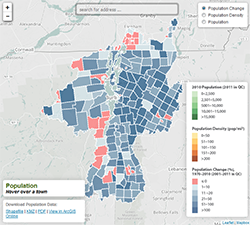
Burlington, Vermont has the highest population density of any town in the Lake Champlain Basin. Photo by Matt McCarthy.
Vermont is known as a rural state, and the North Country of New York is also relatively undeveloped. Those portions of Vermont and New York that lie in the Lake Champlain Basin are no exception. According to 2010 census data, 580,000 people live in the U.S. portion of the Basin: 70% live in Vermont and 30% live in New York. About 25,000 live in the Québec portion, which is also mainly agricultural. The population density of the Basin as a whole is 73 people per square mile. By comparison the population density of the three southern New England states of Connecticut, Massachusetts, and Rhode Island is nearly 800 people per square mile.
The Lake Champlain Basin’s population has grown steadily over the past 50 years, but growth rates vary from one area to another. Much of Vermont has seen steady growth over the last decade, while some parts of New York have experienced significant population declines. As a whole, the population of the Basin has grown by about 6% since 2000.
While the Basin’s population density is generally quite low, some population centers have significantly higher densities. Densities are particularly high in some areas along the Lake’s shoreline and on major tributaries, where towns were established early on for ease of transportation or to harness the water’s energy for industry.
Increases in population and the associated growth in development can have consequences for water quality and ecosystem integrity. Increased development in population centers can result in more impervious area that contributes to flooding and pollutant loading, while growth in lower density suburban areas and in rural areas can result in habitat fragmentation. Careful watershed planning can help to alleviate the pressure from this growth.
More on Population in the Basin
- Vermont Population Projections (State of Vermont)
- Vermont State Data Center (University of Vermont)
- Adirondack Park Population Trends (Adirondack Park Agency)
LCBP Links

LCBP Home
Population growth can lead to increased stormwater runoff, but homeowners can help to prevent pollution.
Learn More →

State of the Lake
Thoughtful land use planning can help to reduce the impacts of flooding on growing communities.
Learn more →

Opportunities for Action
Sustainable economic development is a priority in the Lake Champlain management plan Opportunities for Action.
Find out more →


 Lake Champlain Basin Program
Lake Champlain Basin Program